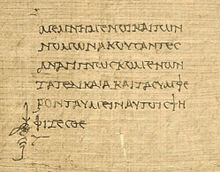- Coronis (textual symbol)
-
For the diacritic used to mark synalepha between two words, see crasis.
 The final lines of Hypereides' In Philippidem with a coronis (in concert with forked paragraphos) marking the end of the speech (P.Lit.Lond. 134 col. ix, 2nd century BCE).
The final lines of Hypereides' In Philippidem with a coronis (in concert with forked paragraphos) marking the end of the speech (P.Lit.Lond. 134 col. ix, 2nd century BCE).
A coronis or koronis (Ancient Greek: κορωνίς, plural κορωνίδες, korōnides) is a textual symbol found in ancient Greek papyri that was used to mark the ends of entire works or major sections in poetic and prose texts.[1] Coronides were placed most often in the left-hand margin of the text and were generally accompanied by a paragraphos or forked paragraphos.
Contents
Etymology
Liddell and Scott's Greek–English Lexicon gives the basic meaning of korōnis as "crook-beaked" from which a general meaning of "curved" is supposed to have derived.[2] Pierre Chantraine concurs and derives the word from κορώνη (korōnē), "crow", assigning the meaning of the epithet's use in reference to the textual symbol to the same semantic range of "curve".[3] But, given the fact that the earliest coronides actually take the form of birds, there has been debate about whether the name of the textual symbol initially referred to use of a decorative bird to mark a major division in a text or if these pictures were a secondary development that played upon the etymological relation between korōnē, "crow", and korōnis, as in "curved".[4]
Examples
-
Detail of P.Berol. inv. 9875 col. v (late fourth or early third century BCE), showing the coronis at the beginning of the "sphragis" in the Persae of Timotheus of Miletus.
-
Detail of P.Lit.Lond. 96 col. xiii (late first–early second century CE): coronis (with forked paragraphos) marking the end of Herodas, Mimiamb 2 followed by the title and beginning of Mimiamb 3.
-
P.Oxy. X 1231 fr. 56 (second century CE), showing a coronis, end-title and verse count at the close of Sappho book one.
-
Detail of P.Oxy. X 1234 fr. 2 col. i (second century CE), with the coronis used to mark the end of a poem by Alcaeus.
See also
Works Cited
- Chantraine, P. Dictionnaire étymologique de la langue grecque (Paris: Éditions Klincksieck, 1968).
- Liddell, H. G. et al. A Greek–English Lexicon, 9th ed. (Oxford: OUP, 1996).
- Schironi, F. Τὸ Μέγα Βίβλιον: Book-Ends, End-Titles, and Coronides in Papyri with Hexametric Poetry (Durham, NC: The American Societ of Papyrologists, 2010).
- Turner, E. G. Greek Manuscripts of the Ancient World, 2nd rev. ed. P.J. Parsons (London: Institute of Classical Studies, 1987).
Notes
Categories:- Palaeography
- Punctuation
- Writing system stubs
-
Wikimedia Foundation. 2010.




